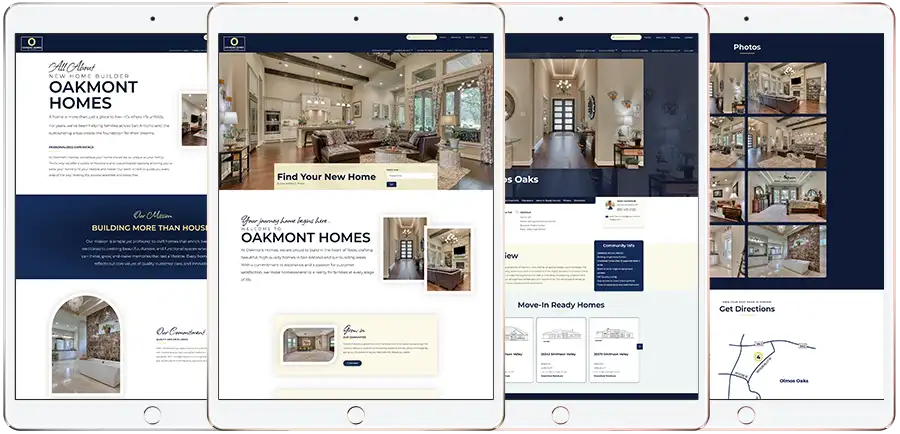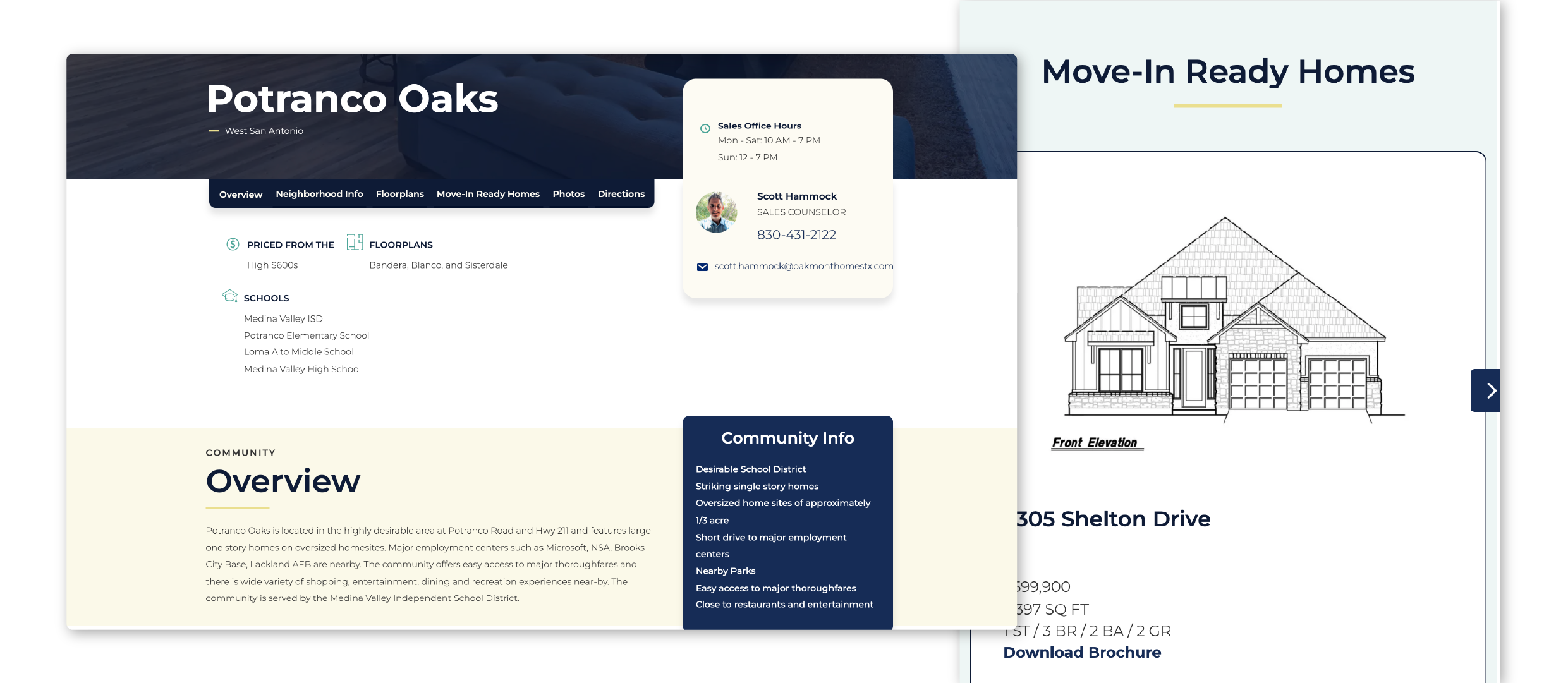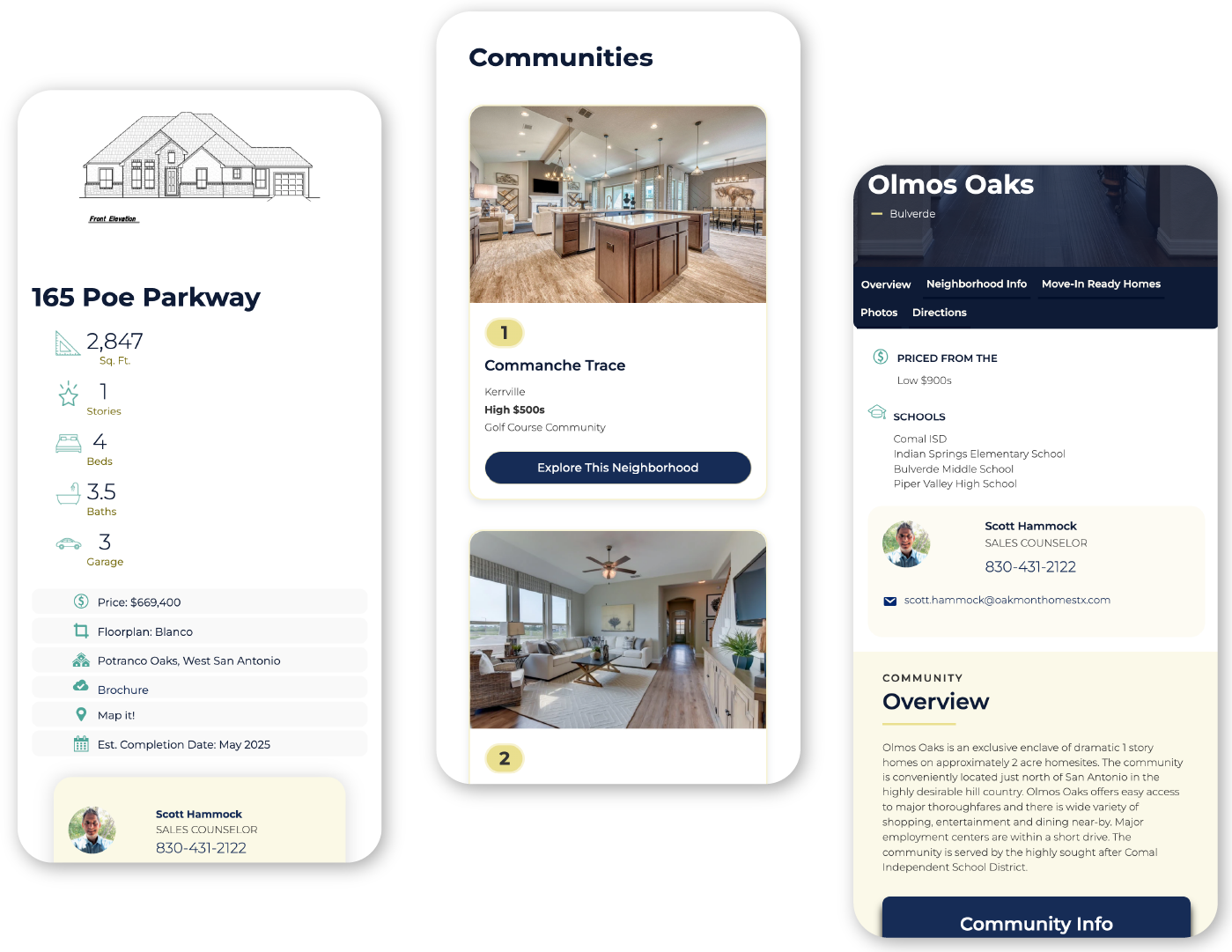There’s a reason why people love watching those home renovation shows. It’s not just about the pretty backsplash or the dreamy walk-in closet. It’s about transformation. Taking something simple (or sometimes a hot mess) and turning it into something that makes people stop and say, “Now that’s sharp.”
That’s exactly what we set out to do with Oakmont Homes’ new website—except instead of tile and shiplap, we were working with data relationships, custom fields, and the kind of backend magic that would make your average DIY-er cry into their toolbelt.
Building the Oakmont Homes Website: Where Smart Design Meets Texas Tough
Let me take you behind the scenes of this digital build.
Start With a Strong Foundation (No, Not Concrete)
When Oakmont Homes approached us, they had an idea for the site–going with what they know. After reviewing the content, I knew this couldn’t be a ‘slap-a-few-pictures-of-houses website. No, this had to give buyers an online experience that would feel as thoughtful and well-built as the homes themselves.
My inspiration? Giants like Zillow and Redfin. Not because Oakmont wanted to become the next real estate behemoth, but because those sites do one thing really well: they make it stupid simple for people to find what they want. Great browsing experiences that make users feel immersed in the homes they’re searching for and exploring.
So we got to work.
And when I say “we,” I mean me, a lot of caffeine, and some developer wizardry. I pushed myself on this one. I knew what needed to be done and designed that way. When time came to build, I had to educate myself, experiment, and call my favorite developer, Ryan Waterbury, crying to stretch myself and deliver what the client and their buyers need.
A Database That Doesn’t Make You Cry
Let’s talk about data. (I promise I’ll make this fun.)
Oakmont’s challenge: a system that could handle a variety of home models, features, communities, photo galleries, and status updates without making someone want to throw their laptop across the room.
We designed a structure using custom post types and custom fields so that each piece of data could live in its own tidy little home (pun intended), but also talk to the others when needed. Think of it like a family barbecue—everyone has their own chair, but you can still pass the potato salad.
For example:
- Floor plans are linked to multiple communities
- Communities list which floor plans are available
- Move-in-ready homes show the model, neighborhood, photos, and status
- Everything is filterable, sortable, and easy to update
All of this happens without having to duplicate content or update 17 pages when something changes. One update flows through the system like sweet tea through a summer picnic.
Front-End Design That Doesn’t Get in the Way
Once we had the engine humming behind the scenes, it was time to make sure the website didn’t just function well—it needed to feel good to use. Clean, crisp, and easy on the eyes. Like a linen shirt on a hot Texas day.
We focused on creating a layout that makes sense to real people, not just developers. Obvious, tappable buttons. Smart filters. Floor plan previews. Image galleries that don’t take five years to load. Mobile-friendly because that’s where the world lives now.
Even the copy layout mattered. We used proven eye-scanning patterns (like the Z-pattern and F-pattern—yes, that’s a thing) so users naturally glide through the content without feeling like they need a map and a flashlight.
And let’s not forget the Texas personality baked into the brand. This wasn’t about sounding like a corporate brochure. It was about making people feel like they were talking to a real person who knows the area, knows home buying, and maybe owns a good pair of boots.
Dynamic Displays That Save Time and Sanity
Here’s where things got extra spicy.
Because of how we set up the data relationships, Oakmont can now:
- Add a new community and automatically see related floor plans populate
- Update a single floor plan and watch those changes cascade site-wide
- Toggle a home’s status (Available, Sold, etc.) with one click, and it updates everywhere
- Let users filter results by what matters to them—price, square footage, availability, location, you name it
This isn’t just about bells and whistles. It’s about building a system that makes future updates easy and error-proof. Oakmont’s team doesn’t need a full-time developer to make changes. They can focus on building homes, not battling WordPress.
Testing, Tuning, and a Few Oh-No Moments
Let’s be honest: every build comes with a moment where you question your life choices. Like when the community archive page content wouldn’t link for no reason. Or, while we worked and reworked the community maps to make them look as great on mobile as they did on desktop. Or when we discovered that one plugin decided it didn’t want to play nice.
But that’s part of the process. We test. We tweak. We Google weird error messages at 2 a.m. And in the end, we build something we’re proud of.
What It All Comes Down To
Building a website like Oakmont Homes’ isn’t about flashy design or buzzwords. It’s about making something that works. Something that respects the user’s time, delivers value, and looks dang good doing it.
It’s also about trust. Oakmont trusted us to create something that makes their customers’ lives easier. That’s no small thing.
If your business runs on quality and attention to detail—whether you’re in construction, coaching, financial services, or food service supply—your website should reflect that. Your online presence should work as hard as you do.
Want a website that’s built smart from the studs out? Let’s talk.
Ready to start your own digital renovation? Contact Fat Dog Creatives and let’s build something your customers will love as much as you do.
P.S. If you made it this far, congratulations! You now know more about custom post types than most people ever will. Use this power wisely.




